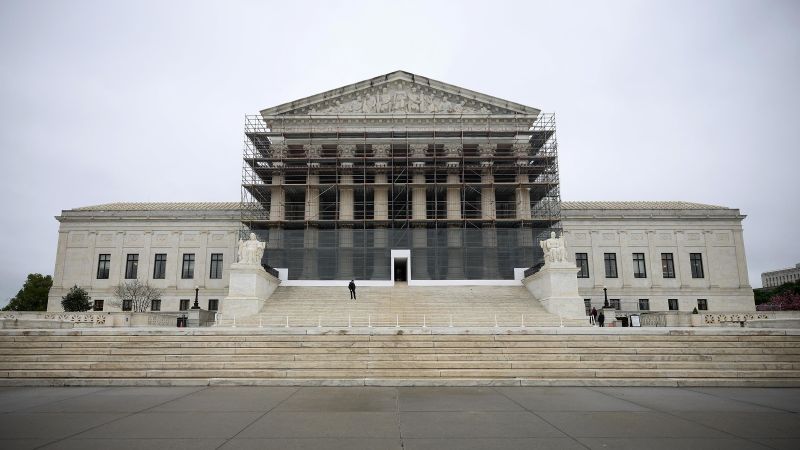On Wednesday, the Supreme Court’s conservative majority demonstrated a willingness to endorse the establishment of a Catholic charter school in Oklahoma, a pivotal decision that could broaden access to taxpayer funding for religious education throughout American school systems. The case, involving St. Isidore of Seville Catholic Virtual School, has attracted considerable attention, reflecting the ongoing debate regarding the intersection of government funding and religious institutions.
The court convened for over two hours of vigorous arguments, making it one of the year’s most scrutinized legal discussions. During this session, the court’s conservative justices challenged an attorney opposing the school about how his stance aligned with a series of recent court decisions that have progressively blurred the lines separating church and state. The intensity of the discourse underscored the complex constitutional questions at play, particularly concerning the First Amendment’s clauses on religious freedom.
Chief Justice John Roberts emerged as a pivotal figure in this debate, posing significant questions to both sides while positioning himself to potentially cast the decisive vote. His involvement is especially crucial as one of the court’s six conservative justices, Justice Amy Coney Barrett, recused herself from the case, leaving the court with a narrower conservative majority to deliberate this issue.
Justice Brett Kavanaugh contributed to the discussion by articulating that opposing the creation of the school could be seen as “rank discrimination against religion.” He emphasized that the fundamental argument from the Catholic school was merely a request not to be excluded due to their religious convictions. Kavanaugh pointed to past court decisions affirming that religious individuals and institutions should not be relegated to a second-class status, a sentiment that reflects the court’s evolving stance on the treatment of religious entities in the context of public funding.
The courtroom dynamics indicated a potential divide among the justices, with three conservative justices appearing to favor the establishment of the school, while the court’s trio of liberal justices opposed it. Should Roberts align with the liberal faction, the resulting 4-4 deadlock would maintain a previous ruling against the school from a lower court, complicating the trajectory of religiously affiliated institutional funding.
Charter schools present a compelling case study in this ongoing national dialogue about educational autonomy. Defined as privately operated but publicly funded, these schools have been presented as an innovative alternative to traditional public education. By 2023, nearly 8,000 charter schools were serving about 3.8 million students nationwide, a significant increase since their inception in the 1990s.
In Oklahoma, the law designates these charter schools as public entities; however, recent Supreme Court rulings suggest a more nuanced interpretation of this classification. The court has previously held that while the government is not obligated to open programs to private entities, it cannot exclude religious organizations if it voluntarily chooses to do so.
A critical case under consideration was a 2022 ruling where the Supreme Court barred Maine from excluding religious schools from a public tuition assistance program. This 6-3 ruling, led by Roberts, reinforced the argument that excluding religious institutions from such programs infringes upon the First Amendment’s protection of free exercise of religion.
During the arguments, Chief Justice Roberts indicated uncertainty about whether the Maine decision could be applied in Oklahoma. He highlighted the greater extent of state involvement in charter school operations in Oklahoma compared to the more passive role noted in the Maine case. This distinction has significant implications, suggesting that degrees of state involvement could affect the constitutionality of funding for religiously affiliated schools.
As the discussion unfolded, Roberts also drew comparisons to a previous ruling that favored a Catholic foster care agency’s refusal to work with same-sex couples under a contract with the city of Philadelphia. He challenged the attorney opposing the school to explain the differences between that case and the present scenario involving state-funded education.
The implications of a favorable ruling for St. Isidore could redefine charter schools as private entities in the educational landscape, even as state laws define them as public schools. Critics fear that such a decision could prompt a wave of applications for religious charter schools seeking public funding or lead some states to prohibit or restrict charter schools altogether.
Justice Neil Gorsuch emphasized the potential “boomerang effect” of such a ruling, questioning whether the consequences might rebound negatively on existing charter school frameworks.
The arguments were further complicated by changes in administrative policies under the Biden administration concerning charter school regulations, a point raised by Justice Sonia Sotomayor, who questioned the rationale behind the evolving stance of the government.
Ultimately, the Oklahoma Supreme Court had previously sided with state Attorney General Gentner Drummond, who blocked the creation of the St. Isidore school, warning that state funding for the school would equate to a financial benefit to the Catholic Church and set a concerning precedent of diminishing Oklahomans’ freedom to practice their religion without government interference.
As the Supreme Court prepares to deliberate on the case further, this complex interplay of constitutional rights, religious freedoms, and educational policy reflects broader societal tensions regarding the role of religion in public life and governance, signaling a potentially



